Hull J.C. Risk management and Financial institutions
Подождите немного. Документ загружается.

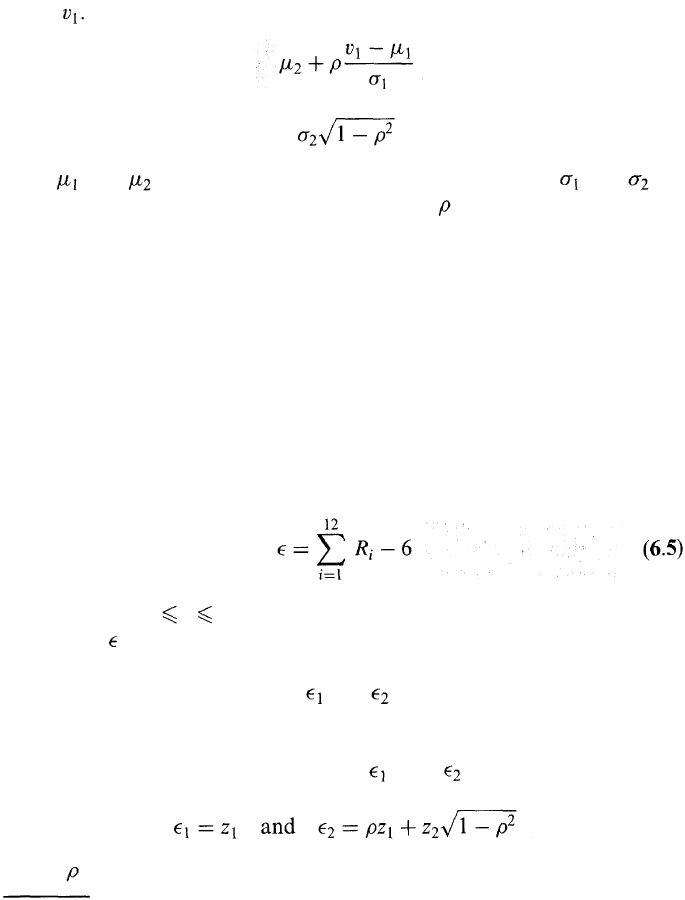
150 Chapter 6
tools for specifying the correlation structure between variables—even
when the distributions of the variables are not normal.
We start by considering a bivariate normal distribution, where there are
only two variables, V
1
and V
2
. Suppose that we know V
1
has some
value Conditional on this, the value of V
2
is normal with mean
and standard deviation
Here and are the unconditional means of V
1
and V
2
; and are
their unconditional standard deviations; and is the coefficient of cor-
relation between V
1
and V
2
. Note that the expected value of V
2
condi-
tional on V
1
is linearly dependent on the value of V
1
. This corresponds to
Figure 6.1a. Also the standard deviation of V
2
conditional on the value of
V
1
is the same for all values of V
1
.
Generating Random Samples from Normal Distributions
Most programming languages have routines for sampling a random
number between 0 and 1 and many have routines for sampling from a
normal distribution.
3
If no routine for sampling from a standardized
normal distribution is readily available, an approximate random sample
can be calculated as
where the R
i
(1 i 12) are independent random numbers between 0
and 1, and is the required sample. This approximation is satisfactory for
most purposes.
When two correlated samples and from bivariate distributions are
required, an appropriate procedure is as follows. Independent samples z
1
and z
2
from a univariate standardized normal distribution are obtained as
just described. The required samples and are then calculated as
follows:
where is the coefficient of correlation.
3
In Excel the instruction =NORMSINV(RAND()) gives a random sample from a
normal distribution.
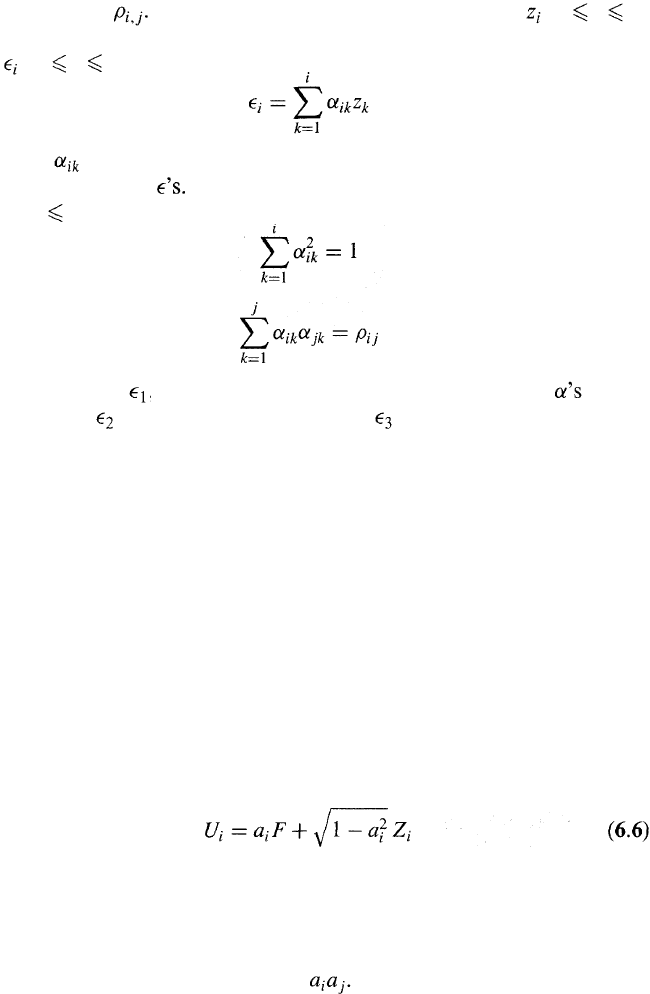
Correlations and Copulas
151
Consider next the situation where we require n correlated samples from
normal distributions and the coefficient of correlation between sample i
and sample j is We first sample n independent variables (1 i n)
from univariate standardized normal distributions. The required samples
are (1 i n), where
and the are parameters chosen to give the correct variances and
correlations for the
For 1 j < i, we have
and, for all j < i,
The first sample, , is set equal to z\. These equations for the can be
solved so that is calculated from z
1
and z
2
, is calculated from z
1
, z
2
and
z
3
, and so on. The procedure is known as the Cholesky decomposition.
If we find ourselves trying to take the square root of a negative number
when using the Cholesky decomposition, the variance-covariance matrix
assumed for the variables is not internally consistent. As explained in
Section 6.2, this is equivalent to saying that the matrix is not Positive-
semidefinite.
Factor Models
Sometimes the correlations between normally distributed variables are
defined using a factor model. Suppose that U
1
,U
2
,... ,U
N
have standard
normal distributions (i.e., normal distributions with mean 0 and standard
deviation 1). In a one-factor model each U
i
has a component dependent on
a common factor F and a component that is uncorrelated with the other
variables. Formally,
where F and the Z
i
have a standard normal distributions and a
i
is a
constant between —1 and +1. The Z
i
are uncorrelated with each other
and uncorrelated with F. In this model all the correlation between U
i
and
V
j
arises from their dependence on the common factor F. The coefficient
of correlation between U
i
and U
j
is
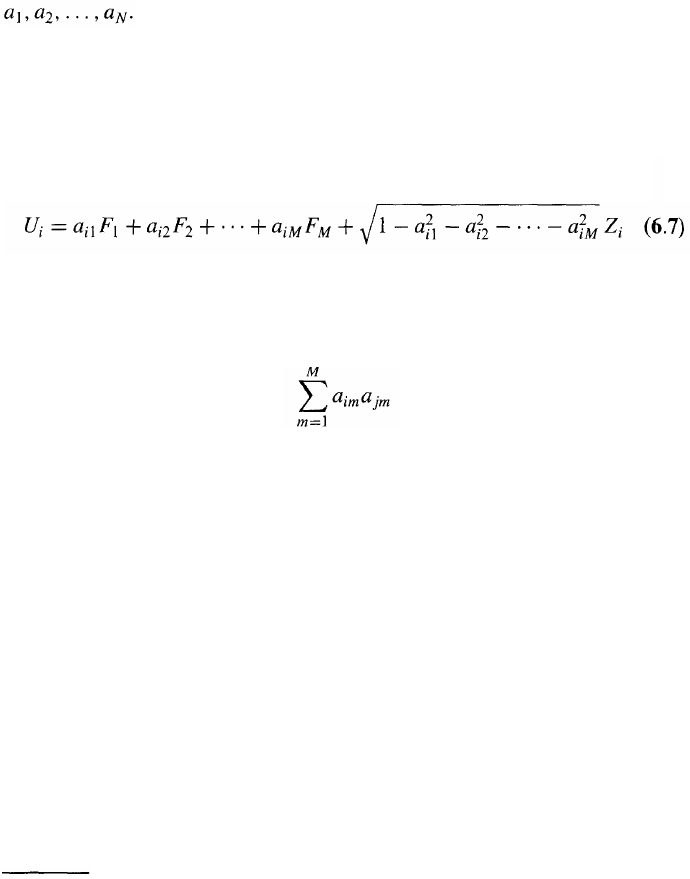
152
Chapter 6
The advantage of a one-factor model is that it imposes some structure
on the correlations. Without assuming a factor model the number of
correlations that have to be estimated for the N variables is N(N — l)/2.
With the one-factor model we need only estimate N parameters:
An example of a one-factor model from the world of
investments is the capital asset pricing model, where the return on a stock
has a component dependent on the return from the market and an
idiosyncratic (nonsystematic) component that is independent of the return
on other stocks (see Section 1.1).
The one-factor model can be extended to a two-, three-, or M-factor
model. In the M-factor model,
The factors F
1
, F
2
,..., F
M
have uncorrelated standard normal distribu-
tions and the Z
i
are uncorrelated both with each other and with the F's.
In this case the correlation between U
i
and U
j
is
6.4 COPULAS
Consider two correlated variables V\ and V
2
.The marginal distribution of
V
1
(sometimes also referred to as the unconditional distribution) is its
distribution assuming we know nothing about V
2
; similarly, the marginal
distribution of V
2
is its distribution assuming we know nothing about V
1
.
Suppose we have estimated the marginal distributions of V
1
and V
2
. How
can we make an assumption about the correlation structure between the
two variables to define their joint distribution?
If the marginal distributions of V
1
and V
2
are normal, an assumption
that is convenient and easy to work with is that the joint distribution of
the variables is bivariate normal.
4
Similar assumptions are possible for
some other marginal distributions. But often there is no natural way of
defining a correlation structure between two marginal distributions. This
is where copulas come in.
4
Although this is a convenient assumption it is not the only one that can be made. There
are many other ways in which two normally distributed variables can be dependent on
each other. See, for example, Problem 6.11.

Correlations and Copulas 153
(a)
(b)
Figure 6.2 Triangular distributions for (a) V
1
and (b) V
2
.
As an example of the application of copulas, suppose that the marginal
distributions of V
1
and V
2
are the triangular probability density functions
shown in Figure 6.2. Both variables have values between 0 and 1. The
density function for V
1
peaks at 0.2, and the density function for V
2
peaks
at 0.5. For both density functions, the maximum height is 2.0. To use what
is known as a Gaussian copula, we map V
1
and V
2
into new variables U
1
and
U
2
that have standard normal distributions. (A standard normal distribu-
tion is a normal distribution with mean 0 and standard deviation 1.) The
mapping is effected on a percentile-to-percentile basis. The 1-percentile
point of the V
1
distribution is mapped to the 1-percentile point of the U
1
distribution; the 10-percentile point of the V
1
distribution is mapped to the
10-percentile point of the U
1
distribution; and so on. The variable V
2
is
mapped into U
2
in a similar way. Table 6.1 shows how values of V
1
are
Table 6.1 Mapping of V
1
, which has the triangular
distribution in Figure 6.2a, to U
1
, which has a standard
normal distribution.
V
1
value
0.1
0.2
0.3
0.4
0.5
0.6
0.7
0.8
0.9
Percentile
of distribution
5.00
20.00
38.75
55.00
68.75
80.00
88.75
95.00
98.75
U
1
value
-1.64
-0.84
-0.29
0.13
0.49
0.84
1.21
1.64
2.24

154
Chapter 6
Table 6.2 Mapping of V
2
, which has the triangular
distribution in Figure 6.2b, to U
2
, which has a standard
normal distribution.
V
2
value
0.1
0.2
0.3
0.4
0.5
0.6
0.7
0.8
0.9
Percentile
of distribution
2.00
8.00
18.00
32.00
50.00
68.00
82.00
92.00
98.00
U
2
value
-2.05
-1.41
-0.92
-0.47
0.00
0.47
0.92
1.41
2.05
mapped into values of U
1
and Table 6.2 how values of V
2
are mapped into
values of U
2
. Consider the V
1
=0.1 calculation in Table 6.1. The cumula-
tive probability that V
1
is less than 0.1 is (by calculating areas of triangles)
0.5 x 0.1 x 1 = 0.05, or 5%. The value 0.1 for V
1
therefore gets mapped to
the 5-percentile point of the standard normal distribution. This is —1.64.
5
The variables U
1
and U
2
have normal distributions. We assume that
they are jointly bivariate normal. This in turn implies a joint distribution
and a correlation structure between V
1
and V
2
. The essence of copulas is
therefore that, instead of defining a correlation structure between V
1
and
V
2
directly, we do so indirectly. We map V
1
and V
2
into other variables
which have "well-behaved" distributions and for which it is easy to define
a correlation structure.
The way in which a copula defines a joint distribution is illustrated in
Figure 6.3. Let us assume that the correlation between U
1
and U
2
is 0.5.
The joint cumulative probability distribution between V
1
and V
2
is shown
in Table 6.3. To illustrate the calculations, consider the first one where we
are calculating the probability that V
1
< 0.1 and V
2
< 0.1. From Tables 6.1
and 6.2, this is the same as the probability that U
1
< —1.64 and
U
2
< -2.05. From the cumulative bivariate normal distribution, this is
0.006 when = 0.5.
6
(The probability would be only 0.02 x 0.05 = 0.001
if =0.)
5
It can be calculated using Excel: NORMSINV(0.05) = -1.64.
6
An Excel function for calculating the cumulative bivariate normal distribution can be
found on the author's website: www.rotman.utoronto.ca/~hull.
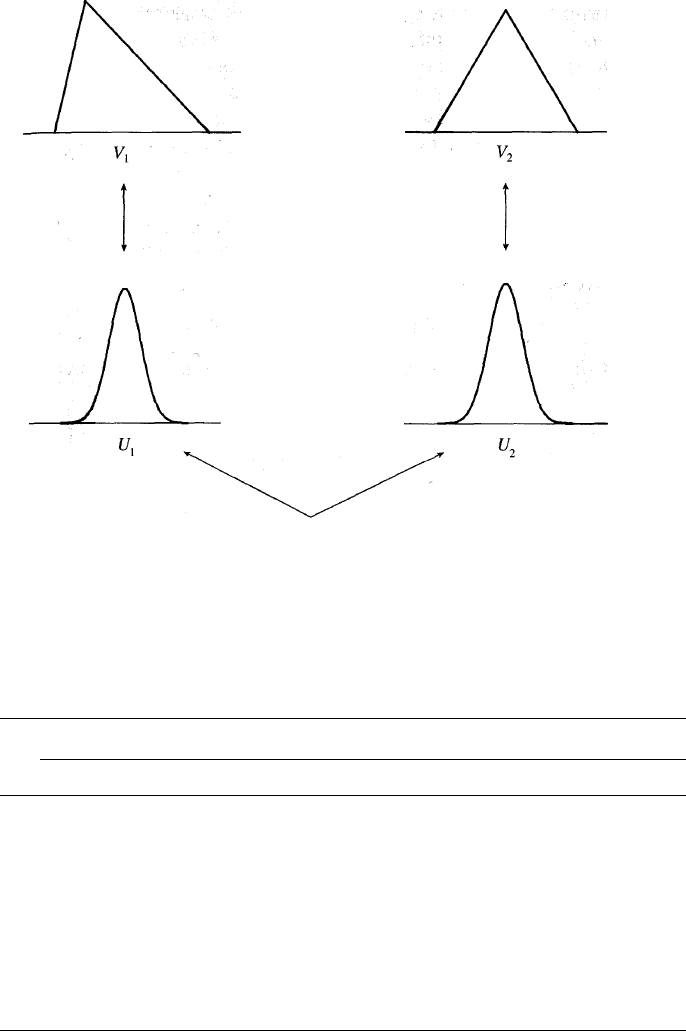
Correlations and Copulas
155
One-to-one
mappings
Correlation assumption
Figure 6.3 The way in which a copula model defines a joint distribution.
Table 6.3 Cumulative joint probability distribution for V
1
and V
2
in a
Gaussian copula model. Correlation parameter =0.5. Table shows the joint
probability that V
1
and V
2
are less than the specified values.
V
1
0.1
0.2
0.3
0.4
0.5
0.6
0.7
0.8
0.9
0.1
0.006
0.013
0.017
0.019
0.019
0.020
0.020
0.020
0.020
0.2
0.017
0.043
0.061
0.071
0.076
0.078
0.079
0.080
0.080
0.3
0.028
0.081
0.124
0.149
0.164
0.173
0.177
0.179
0.180
0.4
0.037
0.120
0.197
0.248
0.281
0.301
0.312
0.318
0.320
V
2
0.5
0.044
0.156
0.273
0.358
0.417
0.456
0.481
0.494
0.499
0.6
0.048
0.181
0.331
0.449
0.537
0.600
0.642
0.667
0.678
0.7
0.049
0.193
0.364
0.505
0.616
0.701
0.760
0.798
0.816
0.8
0.050
0.198
0.381
0.535
0.663
0.763
0.837
0.887
0.913
0.9
0.050
0.200
0.387
0.548
0.683
0.793
0.877
0.936
0.970
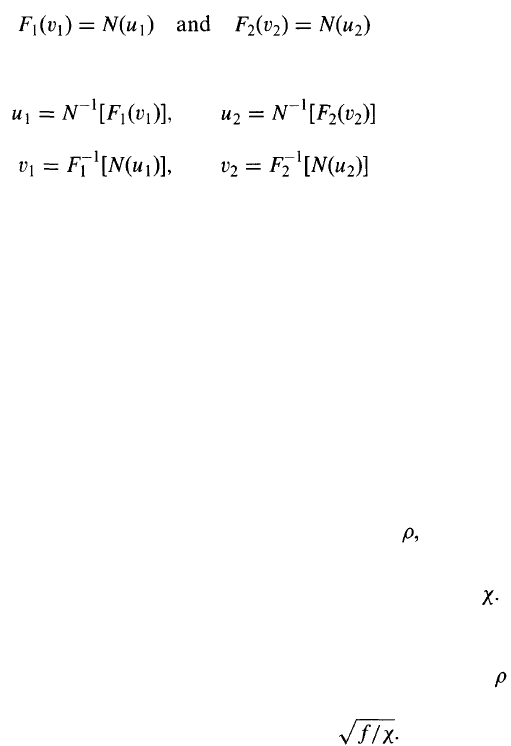
156 Chapter 6
The correlation between U
1
and U
2
is referred to as the copula correl-
ation. This is not, in general, the same as the correlation between V
1
and
V
2
. Since U
1
and U
2
are bivariate normal, the conditional mean of U
2
is
linearly dependent on U
1
and the conditional standard deviation of U
2
is
constant (as discussed in Section 6.3). However, a similar result does not
in general apply to V
1
and V
2
.
Expressing the Approach Algebraically
For a more formal description of the Gaussian copula approach, suppose
that F
1
and F
2
are the cumulative marginal probability distributions of V
1
and V
2
. We map V
1
= v
1
to U
1
= u
1
and V
2
= v
2
to U
2
= u
2
, where
and N is the cumulative normal distribution function. This means that
and
The variables U
1
and U
2
are then assumed to be bivariate normal. The
key property of a copula model is that it preserves the marginal distribu-
tions of V
1
and V
2
(however unusual these may be) while defining a
correlation structure between them.
Other Copulas
The Gaussian copula is just one copula that can be used to define a
correlation structure between V
1
and V
2
. There are many other copulas
leading to many other correlation structures. One that is sometimes used
is the Student t-copula. This works in the same way as the Gaussian
copula except that the variables U
1
and U
2
are assumed to have a
bivariate Student t-distribution. To sample from a bivariate Student
t-distribution with f degrees of freedom and correlation we proceed
as follows:
1. Sample from the inverse chi-square distribution to get a value (In
Excel, the CHIINV function can be used. The first argument is
RAND() and the second is f.)
2. Sample from a bivariate normal distribution with correlation as
described in Section 6.3.
3. Multiply the normally distributed samples by
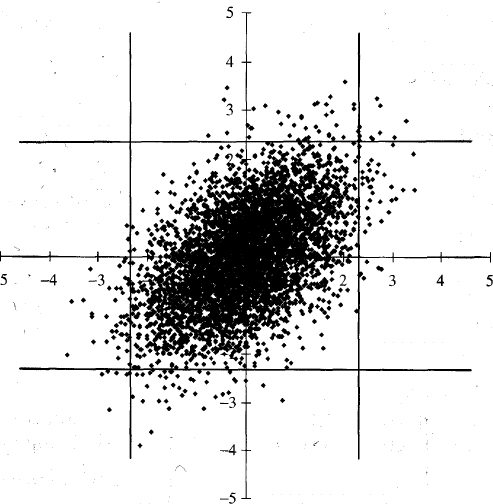
Correlations and Copulas 157
Figure 6.4 shows plots of 5000 random samples from a bivariate normal,
while Figure 6.5 does the same for the bivariate Student t. The correlation
parameter is 0.5 and the number of degrees of freedom for the Student t
is 4. Define a "tail value" of a distribution as a value in the left or right
1 % tail of the distribution. There is a tail value for the normal distribu-
tion when the variable is greater than 2.33 or less than —2.33. Similarly
there is a tail value in the t-distribution when the value of the variable is
greater than 3.75 or less than -3.75. Vertical and horizontal lines in the
figures indicate when tail values occur. The figures illustrate that it is more
common for both variables to have tail values in the bivariate t-distribu-
tion than in the bivariate normal distribution. To put this another way,
the tail correlation is higher in a bivariate t-distribution that in a bivariate
normal distribution. We made the point earlier that correlations between
market variables tend to increase in extreme market conditions so that
Figure 6.1c is sometimes a better description of the correlation structure
between two variables than Figure 6.1a. This has led some researchers to
argue that the Student t-copula provides a better description of the joint
behavior of market variables than the Gaussian copula.
Figure 6.4 5000 random samples from a bivariate normal distribution.
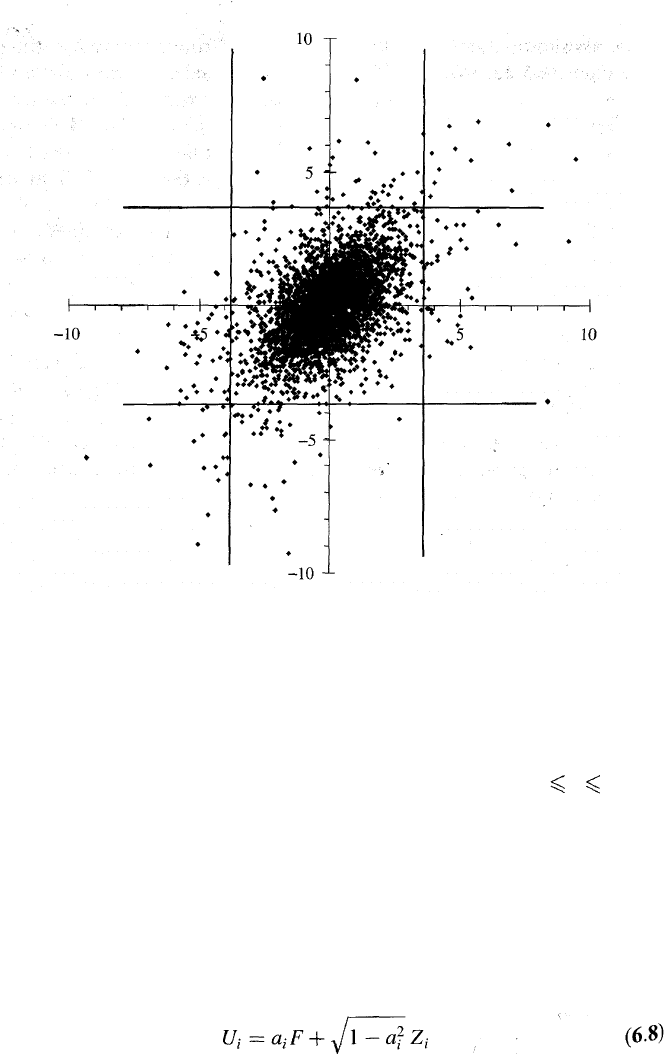
158
Chapter 6
Figure 6.5 5000 random samples from a bivariate Student t-distribution.
Multivariate Copulas
Copulas can be used to define a correlation structure between more than
two variables. The simplest example of this is the multivariate Gaussian
copula. Suppose that there are N variables, V
1
V
2
,...,
V
N
, and that we
know the marginal distribution of each variable. For each i (1 i N), we
transform V
i
into U
i
where U
i
has a standard normal distribution (the
transformation is effected on a percentile-to-percentile basis as above). We
then assume that the U
i
have a multivariate normal distribution.
A Factor Copula Model
In multivariate copula models, analysts often assume a factor model for
the correlation structure between the U
i
. When there is only one factor,
equation (6.6) gives
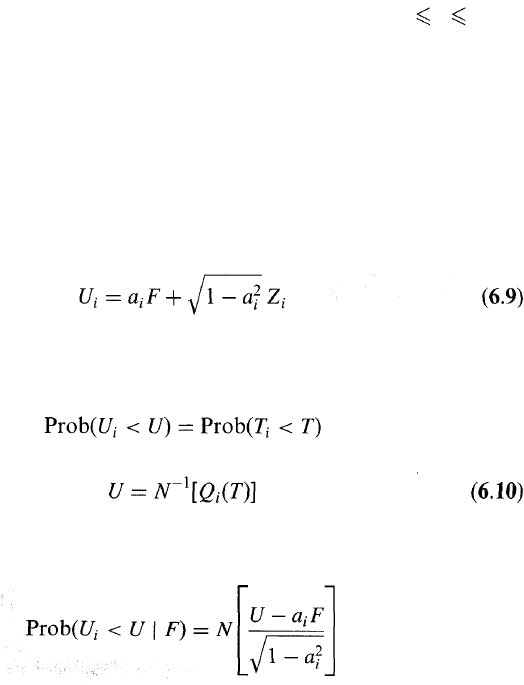
Correlations and Copulas
159
where F and the Z
i
have standard normal distributions. The Z
i
are
uncorrelated with each other and uncorrelated with F. Other factor copula
models are obtained by choosing F and the Z
i
to have other zero-mean
unit-variance distributions. For example, if Z
i
is normal and F has a
Student t-distribution, we obtain a multivariate Student t-distribution
for U
i
. These distributional choices affect the nature of the dependence
between the variables.
6.5 APPLICATION TO LOAN PORTFOLIOS
We now present an application of the one-factor Gaussian copula that
will prove useful in understanding the Basel II capital requirements in
Chapter 7. Consider a portfolio of N companies. Define T
i
(1 i N) as
the time when company i defaults. (We assume that all companies will
default eventually—but that the default time may be a long time, perhaps
even hundreds of years, in the future.) Denote the cumulative probability
distribution of 7} by Q
i
.
In order to define a correlation structure between the T
i
using the one-
factor Gaussian copula model, we map, for each i, T
i
to a variable U
i
that
has a standard normal distribution on a percentile-to-percentile basis. We
assume the factor model in equation (6.8) for the correlation structure
between the U
i
:
where the variables F and Z
i
have independent standard normal distribu-
tions. The mappings between the U
i
and T
i
imply
when
From equation (6.9), the probability that U
i
< U conditional on the
factor value F is
